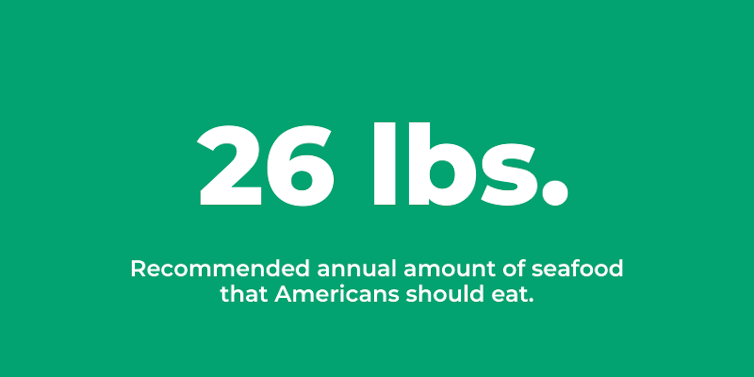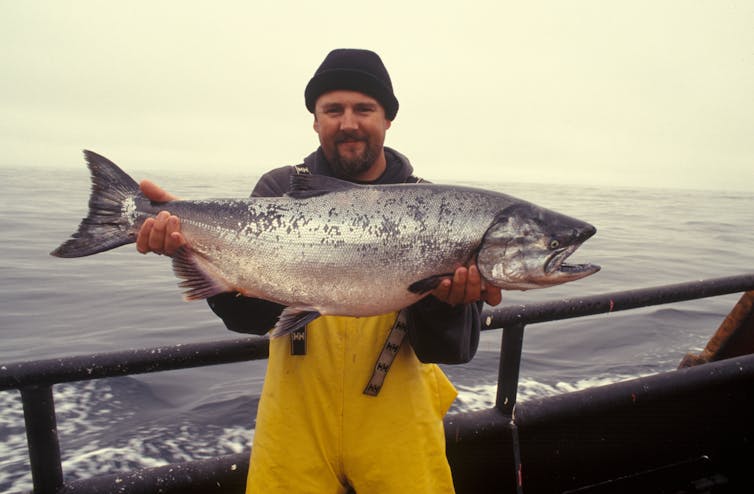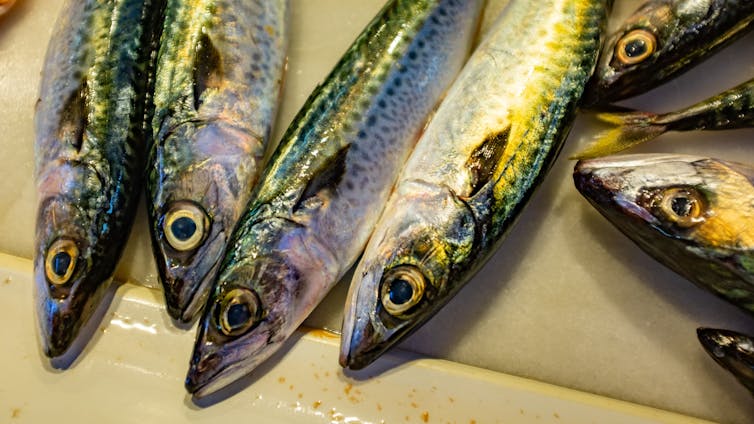Americans don't eat enough fish and miss out on robust health benefits
- Written by Michael Tlusty, Associate Professor of Sustainability and Food Solutions, University of Massachusetts Boston
 CC BY-NC-ND[1]
Eating fish can provide powerful advantages for the heart and brain[2], yet Americans eat less than half[3] of the 26 pounds per year that experts recommend. By contrast, Americans buy seven times more chicken and beef[4] annually than fish.
Why Americans don’t eat more fish has been pondered for a long time[5] by health experts, fish farmers and fishermen themselves. One way to consider this question is production. Consumers can buy a product only if it’s available. The more they buy, theoretically, the more that item will be produced. In this case, a greater demand for fish would be stimulated if more fish were offered for sale.
CC BY-NC-ND[1]
Eating fish can provide powerful advantages for the heart and brain[2], yet Americans eat less than half[3] of the 26 pounds per year that experts recommend. By contrast, Americans buy seven times more chicken and beef[4] annually than fish.
Why Americans don’t eat more fish has been pondered for a long time[5] by health experts, fish farmers and fishermen themselves. One way to consider this question is production. Consumers can buy a product only if it’s available. The more they buy, theoretically, the more that item will be produced. In this case, a greater demand for fish would be stimulated if more fish were offered for sale.
 Salmon caught in the Pacific Ocean is a prize catch.
Photo by NOAA for Unsplash.[6]
More seafood could be made available for American consumers from global ocean sources[7] given that at least 60% of seafood[8] in the U.S. is imported. U.S. aquaculture has the capacity to significantly increase[9]. Research conducted by the National Oceanic and Atmospheric Administration Fisheries[10] also indicates slightly more domestic wild-caught fish can be harvested.
Why eat fish?
Rich in lean protein and long chain omega-3 fatty acids, fish provides robust nutritional benefits that can help ward off chronic disease, boost immunity and reduce inflammation[11] in the body. Seafood provides your body with critical omega-3 fats and minerals, like selenium, zinc, iron and iodine. It also provides vitamins B12 and D that fend off heart disease, among other benefits.
Fish provides such positive benefits for the body that recent USDA Dietary Guidelines[12] offer guidance specific to pregnant women and children based on the finding that seafood consumption leads to cognitive improvement in children[13]. Research shows that integrating seafood into a diet as a way to prevent coronary disease can lead to a potential annual health care savings of US$12.7 billion[14].
Salmon caught in the Pacific Ocean is a prize catch.
Photo by NOAA for Unsplash.[6]
More seafood could be made available for American consumers from global ocean sources[7] given that at least 60% of seafood[8] in the U.S. is imported. U.S. aquaculture has the capacity to significantly increase[9]. Research conducted by the National Oceanic and Atmospheric Administration Fisheries[10] also indicates slightly more domestic wild-caught fish can be harvested.
Why eat fish?
Rich in lean protein and long chain omega-3 fatty acids, fish provides robust nutritional benefits that can help ward off chronic disease, boost immunity and reduce inflammation[11] in the body. Seafood provides your body with critical omega-3 fats and minerals, like selenium, zinc, iron and iodine. It also provides vitamins B12 and D that fend off heart disease, among other benefits.
Fish provides such positive benefits for the body that recent USDA Dietary Guidelines[12] offer guidance specific to pregnant women and children based on the finding that seafood consumption leads to cognitive improvement in children[13]. Research shows that integrating seafood into a diet as a way to prevent coronary disease can lead to a potential annual health care savings of US$12.7 billion[14].
 Dungeness crab are fished off the Pacific coast from California to the Gulf of Alaska.
Photo by Sidney Pearce for Unsplash[15]
Additionally, seafood, as a protein, has a relatively low greenhouse gas production[16]. This benefit is heightened when analyzing the many species[17] that offer both high nutrient density and low greenhouse gas production.
Fish beyond shrimp
The 2015-2020 USDA Dietary Guidelines[18] suggest that Americans eat 26 pounds of seafood each year. The recommended amount would ideally provide 250 mg per day of the important omega-3 fats. Yet because of how American consumers purchase seafood, this provides them with, on average, only 38% of the recommended daily omega-3’s.
Many of the most popular seafoods purchased by consumers are relatively low in omega-3’s, such as shrimp, the most popular seafood in the U.S., comprising nearly 30% of annual fish sales. Considering the 10 species[19] that make up 85% of fish available for Americans to buy in restaurants and markets, only salmon, the second most popular seafood item, has relatively high levels of omega-3’s[20].
Dungeness crab are fished off the Pacific coast from California to the Gulf of Alaska.
Photo by Sidney Pearce for Unsplash[15]
Additionally, seafood, as a protein, has a relatively low greenhouse gas production[16]. This benefit is heightened when analyzing the many species[17] that offer both high nutrient density and low greenhouse gas production.
Fish beyond shrimp
The 2015-2020 USDA Dietary Guidelines[18] suggest that Americans eat 26 pounds of seafood each year. The recommended amount would ideally provide 250 mg per day of the important omega-3 fats. Yet because of how American consumers purchase seafood, this provides them with, on average, only 38% of the recommended daily omega-3’s.
Many of the most popular seafoods purchased by consumers are relatively low in omega-3’s, such as shrimp, the most popular seafood in the U.S., comprising nearly 30% of annual fish sales. Considering the 10 species[19] that make up 85% of fish available for Americans to buy in restaurants and markets, only salmon, the second most popular seafood item, has relatively high levels of omega-3’s[20].
 Fish oil can protect the heart.
Photo by Gunnar Ridderstrom for Unsplash., CC BY-ND[21][22]
There are many species of fish high in omega-3’s that are not regularly purchased or eaten, such as anchovies, herring and sardines. People can replace eating fish by taking supplements[23] or eating other foods, such as eggs[24] that contain omega-3’s, to help overcome this deficiency. However, research shows that eating fish itself is better[25] than supplements, given that a fish filet has a full complement of fats, vitamins, minerals and other supporting molecules[26].
The health and environmental benefits of fish make it a smart choice to buy and eat. With more people at home[27] because of the pandemic, this is a good time to explore recipes[28] and enjoy[29] this nutritionally important food.
[Deep knowledge, daily. Sign up for The Conversation’s newsletter[30].]
Fish oil can protect the heart.
Photo by Gunnar Ridderstrom for Unsplash., CC BY-ND[21][22]
There are many species of fish high in omega-3’s that are not regularly purchased or eaten, such as anchovies, herring and sardines. People can replace eating fish by taking supplements[23] or eating other foods, such as eggs[24] that contain omega-3’s, to help overcome this deficiency. However, research shows that eating fish itself is better[25] than supplements, given that a fish filet has a full complement of fats, vitamins, minerals and other supporting molecules[26].
The health and environmental benefits of fish make it a smart choice to buy and eat. With more people at home[27] because of the pandemic, this is a good time to explore recipes[28] and enjoy[29] this nutritionally important food.
[Deep knowledge, daily. Sign up for The Conversation’s newsletter[30].]
References
- ^ CC BY-NC-ND (creativecommons.org)
- ^ heart and brain (www-tandfonline-com.ezproxy.lib.umb.edu)
- ^ less than half (www.ncbi.nlm.nih.gov)
- ^ seven times more chicken and beef (www.ers.usda.gov)
- ^ for a long time (www.theatlantic.com)
- ^ Photo by NOAA for Unsplash. (unsplash.com)
- ^ global ocean sources (oceanpanel.org)
- ^ 60% of seafood (doi.org)
- ^ significantly increase (blogs.scientificamerican.com)
- ^ National Oceanic and Atmospheric Administration Fisheries (www.fisheries.noaa.gov)
- ^ chronic disease, boost immunity and reduce inflammation (www.seafoodnutrition.org)
- ^ USDA Dietary Guidelines (www.dietaryguidelines.gov)
- ^ cognitive improvement in children (doi.org)
- ^ savings of US$12.7 billion (doi.org)
- ^ Photo by Sidney Pearce for Unsplash (unsplash.com)
- ^ low greenhouse gas production (esajournals.onlinelibrary.wiley.com)
- ^ many species (doi.org)
- ^ 2015-2020 USDA Dietary Guidelines (health.gov)
- ^ 10 species (www.intrafish.com)
- ^ relatively high levels of omega-3’s (www.seafoodnutrition.org)
- ^ Photo by Gunnar Ridderstrom for Unsplash. (unsplash.com)
- ^ CC BY-ND (creativecommons.org)
- ^ taking supplements (doi.org)
- ^ such as eggs (doi.org)
- ^ better (link.springer.com)
- ^ fats, vitamins, minerals and other supporting molecules (www.health.harvard.edu)
- ^ at home (www.forbes.com)
- ^ recipes (www.seafoodnutrition.org)
- ^ enjoy (www.thespruceeats.com)
- ^ Sign up for The Conversation’s newsletter (theconversation.com)
Authors: Michael Tlusty, Associate Professor of Sustainability and Food Solutions, University of Massachusetts Boston

